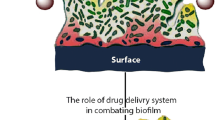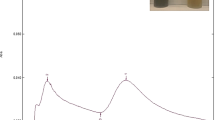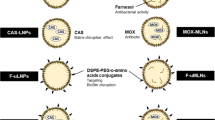Abstract
Biofilm mediated bacterial infections are the key factors in the progression of infectious diseases due to the evolution of antimicrobial resistance. Traditional therapy involving antibiotics is not adequate enough for treatment of such infections due to the increased resistance triggered by biofilm. To overcome this challenge, we developed anacardic acid (Ana) loaded solid lipid nanoparticles (SLNs), further coated with chitosan and DNase (Ana-SLNs-CH-DNase). The DNase coating was hypothesized to degrade the e-DNA, while chitosan was coated to yield positively charged SLNs with additional adhesion to biofilms. The SLNs were developed using homogenization method and further evaluated for particle size, polydispersity index, zeta potential, and entrapment efficiency. Drug excipient compatibility was confirmed by using FT-IR study, while encapsulation of Ana in SLNs was confirmed by X-ray diffraction study. The SLNs demonstrated sustained release for up to 24 h and excellent stability at room temperature for up to 3 months. The developed SLNs were found non-toxic against human immortalized keratinocyte (HaCaT) cells while demonstrated remarkably higher antimicrobial efficacy against Staphylococcus aureus. Excellent effect of the developed SLNs on minimum biofilm inhibition concentration and minimum biofilm eradication concentration further confirmed the superiority of the developed formulation strategy. A significant (p < 0.05) reduction in biofilm thickness and biomass, as confirmed by confocal laser scanning microscopy, was observed in the case of developed SLNs in comparison with control. Cumulatively, the results suggest the enhanced efficacy of the developed formulation strategy to overcome the biofilm-mediated antimicrobial resistance.

Graphical abstract








Similar content being viewed by others
References
Baelo A, Levato R, Julián E, Crespo A, Astola J, Gavaldà J, et al. Disassembling bacterial extracellular matrix with DNase-coated nanoparticles to enhance antibiotic delivery in biofilm infections. J Control Release. 2015;209:150–8.
Singh B, Vuddanda PR, V MR, Kumar V, Saxena PS, Singh S. Cefuroxime axetil loaded solid lipid nanoparticles for enhanced activity against S. aureus biofilm. Colloids Surf B: Biointerfaces. 2014;121:92–8. https://doi.org/10.1016/j.colsurfb.2014.03.046.
Li P, Chen X, Shen Y, Li H, Zou Y, Yuan G, et al. Mucus penetration enhanced lipid polymer nanoparticles improve the eradication rate of Helicobacter pylori biofilm. J Control Release. 2019;300:52–63. https://doi.org/10.1016/j.jconrel.2019.02.039.
Tan Y, Ma S, Leonhard M, Moser D, Haselmann GM, Wang J, et al. Enhancing antibiofilm activity with functional chitosan nanoparticles targeting biofilm cells and biofilm matrix. Carbohydr Polym. 2018;200:35–42. https://doi.org/10.1016/j.carbpol.2018.07.072.
Alvarado-Gomez E, Martínez-Castañon G, Sanchez-Sanchez R, Ganem-Rondero A, Yacaman MJ, Martinez-Gutierrez F. Evaluation of anti-biofilm and cytotoxic effect of a gel formulation with Pluronic F-127 and silver nanoparticles as a potential treatment for skin wounds. Mater Sci Eng C. 2018;92:621–30. https://doi.org/10.1016/j.msec.2018.07.023.
Mohammed YHE, Manukumar HM, Rakesh KP, Karthik CS, Mallu P, Qin H-L. Vision for medicine: Staphylococcus aureus biofilm war and unlocking key's for anti-biofilm drug development. Microb Pathog. 2018;123:339–47. https://doi.org/10.1016/j.micpath.2018.07.002.
Suresh MK, Biswas R, Biswas L. An update on recent developments in the prevention and treatment of Staphylococcus aureus biofilms. Int J Med Microbiol. 2019;309(1):1–12. https://doi.org/10.1016/j.ijmm.2018.11.002.
Okshevsky M, Regina VR, Meyer RL. Extracellular DNA as a target for biofilm control. Curr Opin Biotechnol. 2015;33:73–80. https://doi.org/10.1016/j.copbio.2014.12.002.
Khelissa SO, Jama C, Abdallah M, Boukherroub R, Faille C, Chihib N-E. Effect of incubation duration, growth temperature, and abiotic surface type on cell surface properties, adhesion and pathogenicity of biofilm-detached Staphylococcus aureus cells. AMB Express. 2017;7(1):191. https://doi.org/10.1186/s13568-017-0492-0.
Girish VM, Liang H, Aguilan JT, Nosanchuk JD, Friedman JM, Nacharaju P. Anti-biofilm activity of garlic extract loaded nanoparticles. Nanomedicine. 2019;20:102009. https://doi.org/10.1016/j.nano.2019.04.012.
Shakeri M, Razavi SH, Shakeri S. Carvacrol and astaxanthin co-entrapment in beeswax solid lipid nanoparticles as an efficient nano-system with dual antioxidant and anti-biofilm activities. LWT. 2019;107:280–90. https://doi.org/10.1016/j.lwt.2019.03.031.
Lin C-H, Chen C-H, Lin Z-C, Fang J-Y. Recent advances in oral delivery of drugs and bioactive natural products using solid lipid nanoparticles as the carriers. J Food Drug Anal. 2017;25(2):219–34. https://doi.org/10.1016/j.jfda.2017.02.001.
Bolla PK, Kalhapure RS, Rodriguez VA, Ramos DV, Dahl A, Renukuntla J. Preparation of solid lipid nanoparticles of furosemide-silver complex and evaluation of antibacterial activity. J Drug Deliv Sci Technol. 2019;49:6–13. https://doi.org/10.1016/j.jddst.2018.10.035.
Gordillo-Galeano A, Mora-Huertas CE. Solid lipid nanoparticles and nanostructured lipid carriers: a review emphasizing on particle structure and drug release. Eur J Pharm Biopharm. 2018;133:285–308. https://doi.org/10.1016/j.ejpb.2018.10.017.
Garcês A, Amaral MH, Sousa Lobo JM, Silva AC. Formulations based on solid lipid nanoparticles (SLN) and nanostructured lipid carriers (NLC) for cutaneous use: a review. Eur J Pharm Sci. 2018;112:159–67. https://doi.org/10.1016/j.ejps.2017.11.023.
Fulaz S, Vitale S, Quinn L, Casey E. Nanoparticle–biofilm interactions: the role of the EPS matrix. Trends Microbiol. 2019;27(11):915–26. https://doi.org/10.1016/j.tim.2019.07.004.
Parasa LS, Tumati S, Prasad C, Kumar LCAJIJoPS. In vitro antibacterial activity of culinary spices aniseed, star anise and cinnamon against bacterial pathogens of fish. 2012;4:667–70.
Hamad FB, Mubofu EB. Potential biological applications of bio-based anacardic acids and their derivatives. Int J Mol Sci. 2015;16(4):8569–90. https://doi.org/10.3390/ijms16048569.
Muroi H, Nihei K-I, Tsujimoto K, Kubo IJB. Chemistry m. Synergistic effects of anacardic acids and methicillin against methicillin resistant Staphylococcus aureus. Bioorg Med Chem. 2004;12(3):583–7.
Kubo J, Lee JR, Kubo IJJA, Chemistry F. Anti-Helicobacter pylori agents from the cashew apple. J Agric Food Chem. 1999;47(2):533–7.
Kubo I, Muroi H, Himejima M, Yamagiwa Y, Mera H, Tokushima K et al. Structure-antibacterial activity relationships of anacardic acids. 1993;41(6):1016–9.
Paramashivappa R, Kumar PP, Vithayathil PJ, Rao AS. Novel method for isolation of major phenolic constituents from cashew (Anacardium occidentale L.) nut shell liquid. J Agric Food Chem. 2001;49(5):2548–51. https://doi.org/10.1021/jf001222j.
Yuliana M, Bich TNT, Faika S, Huynh LH, Soetaredjo FE, Ju YH. Separation and purification of cardol, cardanol and anacardic acid from cashew (Anacardium occidentale L.) nut-shell liquid using a simple two-step column chromatography. J Taiwan Inst Chem Eng. 2014;45(5):2187–93. https://doi.org/10.1016/j.jtice.2014.07.012.
Luo Y, Teng Z, Li Y, Wang Q. Solid lipid nanoparticles for oral drug delivery: chitosan coating improves stability, controlled delivery, mucoadhesion and cellular uptake. Carbohydr Polym. 2015;122:221–9. https://doi.org/10.1016/j.carbpol.2014.12.084.
Islan GA, Tornello PC, Abraham GA, Duran N, Castro GR. Smart lipid nanoparticles containing levofloxacin and DNase for lung delivery. Design and characterization. Colloids Surf B: Biointerfaces. 2016;143:168–76. https://doi.org/10.1016/j.colsurfb.2016.03.040.
Butani D, Yewale C, Misra A. Topical amphotericin B solid lipid nanoparticles: design and development. Colloids Surf B: Biointerfaces. 2016;139:17–24. https://doi.org/10.1016/j.colsurfb.2015.07.032.
Ayan AK, Yenilmez A, Eroglu H. Evaluation of radiolabeled curcumin-loaded solid lipid nanoparticles usage as an imaging agent in liver-spleen scintigraphy. Mater Sci Eng C. 2017;75:663–70. https://doi.org/10.1016/j.msec.2017.02.114.
Siewert M, Dressman J, Brown CK, Shah VP, Aiache J-M, Aoyagi N, et al. FIP/AAPS guidelines to dissolution/in vitro release testing of novel/special dosage forms. AAPS PharmSciTech. 2003;4(1):43–52. https://doi.org/10.1208/pt040107.
Silva AC, Kumar A, Wild W, Ferreira D, Santos D, Forbes B. Long-term stability, biocompatibility and oral delivery potential of risperidone-loaded solid lipid nanoparticles. Int J Pharm. 2012;436(1):798–805. https://doi.org/10.1016/j.ijpharm.2012.07.058.
Sharma M, Gupta N, Gupta S. Implications of designing clarithromycin loaded solid lipid nanoparticles on their pharmacokinetics, antibacterial activity and safety. RSC Adv. 2016;6(80):76621–31. https://doi.org/10.1039/C6RA12841F.
Patel KK, Tripathi M, Pandey N, Agrawal AK, Gade S, Anjum MM, et al. Alginate lyase immobilized chitosan nanoparticles of ciprofloxacin for the improved antimicrobial activity against the biofilm associated mucoid P. aeruginosa infection in cystic fibrosis. Int J Pharm. 2019;563:30–42. https://doi.org/10.1016/j.ijpharm.2019.03.051.
Anjum MM, Patel KK, Pandey N, Tilak R, Agrawal AK, Singh S. Development of anacardic acid/hydroxypropyl-β-cyclodextrin inclusion complex with enhanced solubility and antimicrobial activity. J Mol Liq. 2019;112085:112085. https://doi.org/10.1016/j.molliq.2019.112085.
Patel KK, Surekha DB, Tripathi M, Anjum MM, Muthu MS, Tilak R, et al. Antibiofilm potential of silver sulfadiazine-loaded nanoparticle formulations: a study on the effect of DNase-I on microbial biofilm and wound healing activity. Mol Pharm. 2019;16(9):3916–25. https://doi.org/10.1021/acs.molpharmaceut.9b00527.
Patel KK, Agrawal AK, Anjum MM, Tripathi M, Pandey N, Bhattacharya S, et al. DNase-I functionalization of ciprofloxacin-loaded chitosan nanoparticles overcomes the biofilm-mediated resistance of Pseudomonas aeruginosa. Appl Nanosci. 2019;10:563–75. https://doi.org/10.1007/s13204-019-01129-8.
Jain A, Thakur K, Sharma G, Kush P, Jain UK. Fabrication, characterization and cytotoxicity studies of ionically cross-linked docetaxel loaded chitosan nanoparticles. Carbohydr Polym. 2016;137:65–74. https://doi.org/10.1016/j.carbpol.2015.10.012.
Nafee N, Husari A, Maurer CK, Lu C, de Rossi C, Steinbach A, et al. Antibiotic-free nanotherapeutics: ultra-small, mucus-penetrating solid lipid nanoparticles enhance the pulmonary delivery and anti-virulence efficacy of novel quorum sensing inhibitors. J Control Release. 2014;192:131–40. https://doi.org/10.1016/j.jconrel.2014.06.055.
Shah P, Bush A, Canny G, Colin A, Fuchs H, Geddes D, et al. Recombinant human DNase I in cystic fibrosis patients with severe pulmonary disease: a short-term, double-blind study followed by six months open-label treatment. Eur Respir J. 1995;8(6):954–8.
Messiaen A-S, Forier K, Nelis H, Braeckmans K, Coenye T. Transport of nanoparticles and tobramycin-loaded liposomes in Burkholderia cepacia complex biofilms. PLoS ONE. 2013;8(11):e79220. https://doi.org/10.1371/journal.pone.0079220.
Acknowledgments
The authors acknowledge financial support from the Department of Science & Technology (DST), grant no: DST/SSTP/UP/2013-14/12TH PLAN/132, Government of India. The authors would also like to acknowledge the Central Instrument Facility Centre (CIFC), Indian Institute of Technology (Banaras Hindu University), Varanasi, for providing the instrument facilities
Author information
Authors and Affiliations
Corresponding authors
Ethics declarations
Conflict of interest
The authors declare no conflict of interest in the present work.
Additional information
Publisher’s note
Springer Nature remains neutral with regard to jurisdictional claims in published maps and institutional affiliations.
Electronic supplementary material
ESM 1
(DOCX 134 kb)
Rights and permissions
About this article
Cite this article
Anjum, M.M., Patel, K.K., Dehari, D. et al. Anacardic acid encapsulated solid lipid nanoparticles for Staphylococcus aureus biofilm therapy: chitosan and DNase coating improves antimicrobial activity. Drug Deliv. and Transl. Res. 11, 305–317 (2021). https://doi.org/10.1007/s13346-020-00795-4
Published:
Issue Date:
DOI: https://doi.org/10.1007/s13346-020-00795-4




